On Tuesday, Aram Sarkisian told the story of a mystery photo featuring an Orthodox priest, whom he eventually identified as the Syrian/Antiochian Fr. Job Salloom of Washington, DC. In the course of his investigation, Aram noticed that the mystery priest bore a striking resemblance to a priest in an earlier image — a 1915 group photo of clergy surrounding the casket of St. Raphael Hawaweeny. That led Aram and me to start another project: an attempt to identify all the clergy in that St. Raphael photo. That photo appears at the top of this article, and I’ve added numbers to make the identification process easier.
Our idea was to identify as many of these men as possible, and then ask our readers for help. We figure that, by “crowdsourcing” the image, we may be able to get the names of every single one of the clergymen pictured.
One of the first problems we ran into was the fact that the visiting Antiochian Metropolitan Germanos Shehadi is nowhere to be found in the photo, although he played a prominent role in the funeral service. And for that matter, there are only 18 or so priests in the photo (and that includes the Russian Bishop Alexander Nemolovsky), but there were many more at the funeral. According to A. Issa’s St. Vladimir’s Seminary thesis on the life of St. Raphael, 22 Syrian priests, three deacons, two bishops (Germanos and Alexander), and an unspecified number of Russian priests were present.
So what gives? Where are Metropolitan Germanos and all the rest of the Syrian clergy?
The answer is that they aren’t in the photo, because they weren’t in Brooklyn when this photo was taken — because this photo is not from St. Raphael’s funeral. Raphael died on February 27, 1915. The funeral took place on March 7, which allowed enough time for the Syrian clergy to converge on Brooklyn. But the day after Raphael’s death, on Sunday, February 28, Bishop Alexander celebrated the Divine Liturgy in the Syrian cathedral. I’m nearly certain that the above photo was taken after this service. Metropolitan Germanos hadn’t even left Montreal for New York yet, and many other Syrian priests were only just making their travel arrangements.
So that’s our first clue: it’s very likely that all of the clergy in this photo lived within an afternoon’s train ride of Brooklyn, because that’s all the time they would have had to get there. Let’s look at each clergyman one by one, and see what we can find here at the outset.
#1: Fr. Job Salloom
It’s fitting that the man who started this whole project, Fr. Job Salloom, is #1 on our list (by virtue of standing at the far left of the photo). Check out Aram’s recent article to learn more about Fr. Job.
#2: Unidentified
#3: Unidentified
#4: Fr. Michael Husson (?)
Fr. Michael Husson was an active priest in America from 1902 to 1937, and most of that time was spent at St. George Church in Worcester, MA. His career encompassed a huge swath of Antiochian history in America, from St. Raphael’s consecration in 1904 through the dueling consecrations of Antony Bashir and Samuel David in 1936. In between, Fr. Michael’s parish was the first to throw its lot in with Metropolitan Germanos Shehadi’s “Antacky” faction. Later, in 1924, Worcester was the site of the consecration of Victor Abo-Assaly, the first primate of the modern Antiochian Archdiocese of North America. The above photo of Fr. Michael was taken in about 1900, so we can assume he looked a little different standing around St. Raphael’s casket in 1915. That said, Aram and I both think that Clergyman #4 looks rather similar to Fr. Michael — enough so that it could be him, 15 years later. If any of our readers has a later photo of Fr. Michael, please let us know. (And for a bit more on Fr. Michael, check out this article I wrote a couple of months ago.)
#5: Fr. Michael Ilyinsky
In 1915, 48-year-old Fr. Michael Ilyinsky was on the staff of St. Platon Russian seminary in Tenafly, NJ. In 1935, after the death of his wife, Fr. Michael was consecrated a bishop, taking the monastic name Makary, and served as the first Dean of St. Vladimir’s Seminary from 1938 to 1944. In 1946, Archbishop Makary left the Metropolia and in 1947 became Exarch (primate) of the Moscow Patriarchate’s Exarchate of North and South America. In 1952, he was elevated to the rank of Metropolitan. The above photograph was taken slightly before his death in 1953.
#6: Fr. George Maloof
Fr. George Maloof was the founding priest of St. George Church in Boston, and he served there from 1900 until his death in 1920. The photo on the right is from the St. George parish website. Fr. George was recently described as “an intensely spiritual man whose only concern was the welfare of his flock.”
#7: Fr. Aftimios Ofiesh
This is an easy one. Fr. Aftimios Ofiesh was one of the leading candidates to replace St. Raphael as Bishop of Brooklyn, and he was consecrated to the post in 1917. But a large portion of the Syrians rejected Aftimos’ authority in favor of Metropolitan Germanos, creating the “Russy-Antacky schism.” Aftimios eventually created his own jurisdiction, the American Orthodox Catholic Church, which drifted to the fringes of mainstream Orthodoxy. In 1933, Aftimios married a young woman, effectively ending his ecclesiastical career.
#8: Archdeacon Emmanuel Abo-Hatab
Another easy one: Archdeacon Emmanuel was St. Raphael’s right-hand man, and he accompanied the great bishop on many of his missionary trips. Adn. Emmanuel was just 25 in 1915 — far below the canonical minimum age for consecration — but he was one of the top candidates to succeed Raphael. In the end, Aftimios Ofiesh was chosen instead, and his former rival Emmanuel became a loyal lieutenant. In 1927, Emmanuel was consecrated a bishop for Aftimios’ American Orthodox Catholic Church, but two years later, Emmanuel bolted to join the Russian Metropolia. Aftimios had fallen out of favor with the Metropolia, and Emmanuel replaced him as bishop for the Syrians. Just a few weeks after Aftimios got married in 1933, Emmanuel died.
#9: Bishop Alexander Nemolovsky
In 1915, Alexander Nemolovsky was the Bishop of Alaska, yet from the departure of Archbishop Platon in mid-1914 until the arrival of Archbishop Evdokim in May 1915, Alexander was also serving as temporary administrator of the entire Russian Archdiocese of North America. Later, after the Bolshevik Revolution and the departure of Abp. Evdokim for the All-Russian Sobor, Alexander again served as temporary administrator, and was elected as diocesan primate at the 2nd All-American Sobor in 1919. The embattled Abp. Alexander served but three years in this post, and departed for Constantinople in 1922. He eventually became the Archbishop of Brussels under the Patriarchate of Constantinople, then the Patriarchate of Moscow, and was elevated to the rank of Metropolitan in 1959. Met. Alexander died in Belgium in 1960.
#10: Unidentified
We don’t know who this man is, but he appears to be either a deacon or a subdeacon.
#11: Unidentified
This priest may be Russian, rather than Syrian.
#12: Fr. Basil Kerbawy
Fr. Basil Kerbawy was dean of St. Nicholas Cathedral in Brooklyn (where the casket photo was taken) from 1907 until his death in 1937. He was married and thus ineligible to become a bishop, but Fr. Basil threw his weight behind Archdeacon Emmanuel. He had a sort of love-hate relationship with Aftimios, sometimes serving as an ally, other times as an enemy. Awhile back, I wrote about a rather amusing incident involving Fr. Basil’s beard, some rotten vegetables, and the Mayor of New York. In 1924, he made a pastoral visit to Jamaica, which is where the grainy newspaper photo on the right was taken.
#13: Possibly Fr. Ingram Nathaniel Irvine
Unfortunately, Clergyman #13’s face is obscured, so we can’t tell for sure whether he has Irvine’s distinctive, gigantic mustache — but if you look closely, it looks like he might. From other images, we know that Irvine had a bald head, just like #13. Also, both men appear to have dark eyebrows. We’re almost certain that Irvine was present for the casket photo, given that he was St. Raphael’s English secretary. None of the other priests in the photo look like Irvine, so we’re reasonably confident that we’ve made the right identification.
#14: Unidentified
#15: Unidentified
#16: Unidentified
#17: Unidentified
#18: Fr. Joseph Elia Xanthopoulos
I’ve written quite a bit about the few Greek priests who served in the Russian Mission, but until we started this project, I had never known about Fr. Joseph Elia Xanthopoulos, a half-Lebanese, half-Greek priest who served in the Syrian Mission. At the time of St. Raphael’s death, he was the pastor of St. Mary Church in Wilkes-Barre, PA. Later, he joined the Greek Archdiocese and served at St. George in Springfield, MA for two decades. He’s a fascinating figure who defies our neat little ethnic categories, and I’d love to learn more about him.
So, that’s it: we’ve got a pretty good idea about 10 of the 18 clergy pictured in the casket photo, but we need your help to identify the other eight (and to confirm the identities of the priests we’ve already found). Next week, Aram will be back with a follow-up article, along with more information to help with the identification process. In the meantime, if you’re at an Antiochian parish, see if you can match one of the clergymen in the casket photo to one of your old parish priests. If you have old parish commemorative booklets with photographs, compare them with the unknown faces. If you find any matches, or have pictures that could otherwise help with the identification process, please drop me an email at mfnamee [at] gmail [dot] com. We need your help!
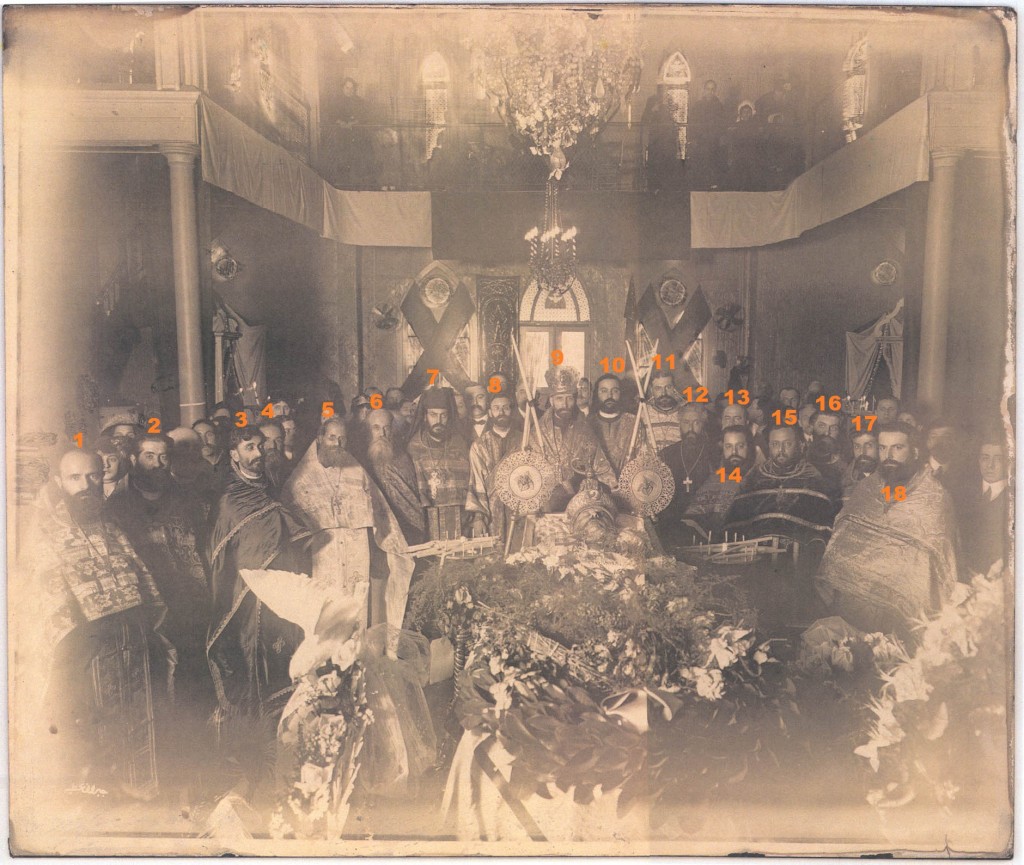
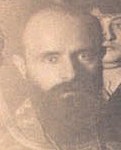






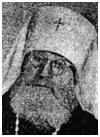

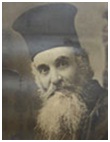

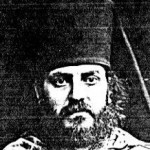



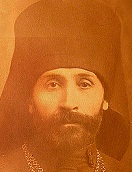



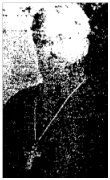








I may have identifications for two more of the priests in this photo:
#3: Fr. Abou-Assaly (later Bishop)
#14: Fr. George Kattouf (later Protosyngellos)
Thanks! But regarding #3 — the future Archbishop Victor Abo-Assaly didn’t come to America until 1923 (unless I’m missing something). What makes you think that this is him? (I’m also not really seeing the resemblance.)